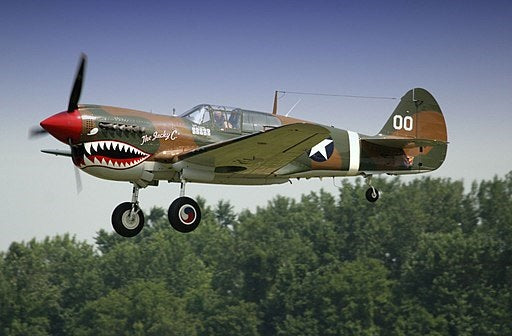The Curtiss P-40 Warhawk, an acclaimed fighter aircraft of the World War II era, remains a symbol of enduring American bravery and ingenuity. In a world consumed by conflict, this iconic warplane etched an unforgettable presence across the expansive skies, serving as both a protector and an aggressor. This detailed examination analyzes the P-40 Warhawk’s performance during World War II, exploring its strengths, weaknesses, and lasting legacy in aviation history.
The Birth of a Legend
Born in 1938, the Curtiss P-40 Warhawk took its inaugural flight when the world stood on the precipice of war. Distinguished by its iconic shark-toothed nose art, this formidable fighter rapidly ascended to the status of an emblem of American air power. Conceived initially as a pursuit aircraft with a primary mission of engaging enemy aircraft, the P-40 Warhawk would transcend these initial design parameters, ultimately leaving an indomitable mark on the conflict.
The Heart of Power
At the core of the P-40 Warhawk lay its robust powerplant—the Allison V-1710 engine. This mechanical masterpiece churned out a formidable 1,150 horsepower, propelling the aircraft to speeds nearing 360 miles per hour (580 km/h). This rugged engine rendered the P-40 Warhawk a formidable adversary in the frenetic ballet of aerial combat.
Adaptability and Versatility
One of the P-40 Warhawk’s standout features was its adaptability. While primarily conceived as an interceptor, it demonstrated remarkable flexibility in various combat roles, excelling in ground attack and close air support missions. This versatility enabled the P-40 Warhawk to pivot effectively across multiple theaters of war, from the arid expanses of North Africa to the lush Pacific Islands, consistently proving its mettle in diverse combat scenarios.
The Crucible of Battle
The P-40 Warhawk earned its spurs amidst some of World War II’s most ferocious aerial battles. It played a pivotal role in the North African campaign, facing off against the formidable German Luftwaffe. While occasionally outmatched in speed and agility, the P-40 Warhawk’s rugged construction and firepower made it a challenging and unyielding foe. Pilots lauded its durability, as it could endure significant damage and return safely to its base.
Acknowledging Limitations and Evolution
The P-40 Warhawk undeniably boasted commendable qualities but didn’t escape its fair share of limitations. Its power-to-weight ratio left it somewhat disadvantaged compared to its peers, and the absence of a supercharger posed challenges at higher altitudes. As the war progressed and more technologically advanced aircraft entered the battlefield, the P-40 Warhawk gradually unveiled the unmistakable markers of its aging design. Nevertheless, it served valiantly, persistently contributing to the Allied war effort.
Conclusion
In the grand narrative of aviation history, the P-40 Warhawk holds a revered position as a reliable and adaptable fighter aircraft of World War II. The combat performance of the P-40 Warhawk, while occasionally eclipsed by aircraft boasting more incredible speed and agility, truly encapsulates the unwavering determination and resilience of its valiant pilots. Despite not being crowned the swiftest or most nimble aircraft of its era, the P-40 Warhawk endures as a poignant emblem of American aviation’s enduring legacy throughout the tumultuous and pivotal years of the Second World War. Its legacy continues to testify to the unwavering human spirit and the timeless fascination surrounding the iconic warbird, the P-40 Warhawk.
For more insights into the P-40E Warhawk and other important military aircraft, visit Aces In Action. Here, you’ll find an amazing piece of artwork by Craig Tinder titled “Return from Canton,” which illustrates the heroism and determination of AVG Ace “Tex Hill” from the famed Flying Tigers. The limited edition canvas print even includes a piece of relic material supplied from their P-40E Warhawk, making it a unique piece of history!
P-40E Warhawk – “Tex” Hill – Framed Panoramic Aviation Art Print – Profile by Artist Craig Tinder
This print was commissioned by the Military Aviation Museum – Virginia Beach, VA with relic material supplied from their P-40E Warhawk. This aircraft was originally transferred to the British as a Kittyhawk 1a serial no. 41-35918, this P-40 was supplied to Russia’s 19th Guards Regiment. The aircraft was recovered in 1992 and upon restoration, now flies in the markings of AVG Ace “Tex” Hill’s P-40E Warhawk, 41-5658 “108”.






Share:
Battle of Leyte Gulf, the story behind "USS Langley CVL-27"
The Evolution of C-130 Hercules: From Conception to Innovation